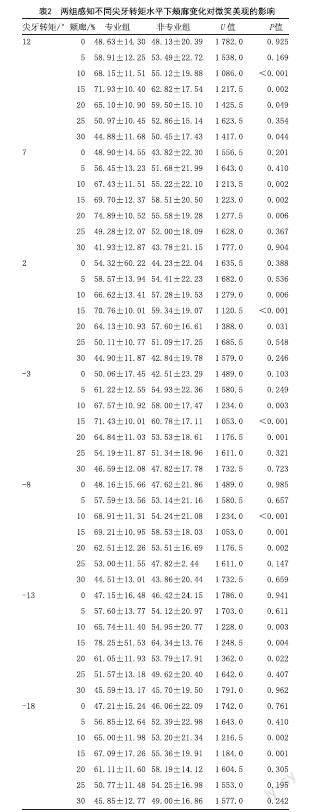上颌尖牙转矩结合颊廊对微笑美影响的研究
梁文慧 周洪 林亭廷 乔虎


[摘要]目的:評价不同上颌尖牙转矩与不同大小的颊廊两两结合后对微笑美的影响。方法:一张成年女性口周微笑相,经过三维数字化模型和图像处理软件拟合,获得49张微笑照片(颊廊调整从0%至30%,间隔5%,尖牙转矩调整从-18°~12°,间隔5°),每张照片赋予相应编号(1~49),打乱照片的顺序将其放在同一相册中,指导60名口腔专业人士和60名非专业人士利用视觉模拟量表对照片的美观程度进行打分。结果用一般线性模型,Kruskal-Wallis检验,Mann-Whitney U检验等统计学方法,P<0.05为差异有统计学意义。结果:①尖牙转矩与颊廊的交互作用无统计学意义(P>0.05);②当转矩不变时,改变颊廊对微笑美学的影响有统计学意义(P<0.05),当颊廊为10%~20%时,得分之间差异具有统计学意义(P<0.05),颊廊为15%时,得分最高(P<0.05);③当颊廊不变时,绝大多数情况下改变尖牙转矩对微笑美的影响无统计学意义(P<0.05)。结论:大多数情况下上颌尖牙转矩与颊廊两两结合后并未发现对微笑美有加强或消减的作用,对美观的影响主要取决于颊廊,可接受的范围为10%~20%,且15%时微笑相最佳。
[关键词]微笑美;上颌尖牙转矩;颊廊;三维数字化模型;视觉模拟量表
[中图分类号]R783 [文献标志码]A [文章编号]1008-6455(2024)03-0076-05
Effect of Maxillary Canine Torque Combined with Buccal Corridor on Smile Esthetics
LIANG Wenhui1,2,3,ZHOU Hong1,2,3,LIN Tingting1,2,3,QIAO Hu1,2,3
(1.Key Laboratory of Shaanxi Province for Craniofacial Precision Medicine Research,College of Stomatology,Xian Jiaotong University,Xian 710004,Shaanxi,China; 2.Laboratory Center of Stomatology,College of Stomatology,Xian Jiaotong University,Xian 710004,Shaanxi,China; 3.Department of Children's Dentofacial Development Management,College of Stomatology,Xian Jiaotong University,Xian 710004,Shaanxi,China)
Abstract: Objective The study wanted to evaluate that the different maxillary canine torques combined with different buccal corridors had an effect on smile esthetics. Methods An adult female perioral smile photograph, fitted with a three-dimensional digital model and image processing software, yielded 49 smile photographs (buccal corridor adjusted from 0%-30% with 5% interval and cuspid torque adjusted from -18° to 12° with 5° interval), each photo was numbered accordingly (from 1 to 49) and the order of the photos was disordered to place them in the same album, and 60 dental professionals and 60 laypersons were instructed to score the aesthetics of the photos by using visual analogues. Results were analyzed by General linear model, Kruskal-Wallis test, Mann-Whitney U test and other statistical methods. Results ①There was no statistical difference in the interaction between canine torque and buccal corridor (P>0.05).②When the canine torque remained constant, the effect of the buccal corridor on smile aesthetics was statistically significant (P<0.05). When the buccal corridor was 10%-20%, the difference between the scores was statistically significant (P<0.05), and when the buccal corridor was 15%, the score was the highest (P<0.05). ③In most cases, when the buccal corridor was unchanged, the effect of the canine torque on smile aesthetics was not statistically significant (P<0.05). Conclusion In most cases, the interaction of the maxillary canine torque and the buccal corridor has not been found to enhance or diminish the esthetics of smile. The impact on aesthetics depends mainly on the buccal corridor, with an acceptable range of 10% to 20% and an optimal smile at 15%.
Key words: smile esthetics; maxillary canine torque; buccal corridor; three-dimensional digital model; visual analogue scale
微笑美学研究已成为当代正畸学的一项重要课题。越来越受到正畸医师的关注,微笑美观也成为多数患者寻求正畸治疗的主要动机之一。颊廊被定义为口角和牙列之间的黑色间隙,一般来说,颊廊过大,微笑不饱满,没有颊廊,笑容又显得呆板,所谓义齿样笑容[1]。因此,一些学者研究认为较小的颊廊容易获得微笑美观[2],但也有学者认为其对微笑美观无影响[3-7]。通常认为,有魅力的微笑由一副具有美感的牙列和与其对应的黑色间隙构成,所以当眼睛注视一个人的微笑时,大脑会反应出黑色间隙与牙齿关系。Yang IH等[8]在研究使用尖牙尖宽度与口角宽度定义颊廊比率,后被广泛用于研究颊廊大小对微笑的研究。而尖牙位于口角,作为前后牙弓的交界,其颊舌向倾斜度被称为转矩[9],纵观国内外对尖牙转矩影响微笑美观的研究较少,总体认为较舌倾的上颌尖牙容易获得和谐的微笑[10-12]。本研究纳入不同大小的尖牙转矩和不同大小的颊廊,观察两两组合后的微笑照片,阐明假设当一个微笑变量对美观不利时,另一个变量的变化是否会改变其对美观的影响,反之亦然,以期对临床诊疗具有重要的指导意义。
1 材料和方法
1.1 研究对象:选择符合大众审美[13-15],微笑迷人的一名成年女性患者,照片经患者本人同意,并签署知情同意书。拍摄姿势性微笑相作为原始图像,截取口周微笑相用于实验研究,以JPEG的格式保存,见图1A。
1.2 研究方法:首先,3shape Trios口腔内扫描仪获取整个牙列(见图1B),将CBCT数据和牙列数据同时导入3shape Ortho Analyzer软件进行匹配,使三维数字牙齿模型与实际牙齿完全一致。定位牙长轴,准确标记牙冠轴面的中心点,即FA点(图1C和图1D),分割并移动牙齿(图1E)。调整尖牙转矩和后牙弓宽度(图1F)。其次,拍摄患者3D面部扫描,参考功能性咬合平面将调整后的数字化模型与其拟合,再以同一口周微笑相作为背景,参考右上中切牙的实际尺寸,将拟合后的数字化模型通过Photoshop软件与其进行匹配,见图2。
最后,生成49张具有不同上颌尖牙转矩和颊廊微笑的照片,颊廊(即BC,0%~30%,间隔5%)和上颌尖牙转矩(即MCT,-18°~12°,间隔5°),随机编号,以JPEG格式保存,并按顺序排放。见图3。
1.3 测量指标:使用100 mm的视觉模拟量表评估吸引力。0表示微笑不具吸引力,100表示微笑最具吸引力。指导60名口腔专业人士(专业组)和60名非专业人士(非专业组)利用VAS量表对49张照片的美观程度进行打分。其中专业组为正畸科的年轻医生以及接受过正畸训练的研究生和进修生,男女各半;非专业组为非正畸专业的研究生和进修生,男女各半。平均年龄20~30岁,有色盲和弱视等疾病的评价者排除在外。观察者端坐在距离电脑屏幕50 cm处,眼睛与画面中性平齐,每张照片的观察时间限制为8 s,每两张照片之间的最大观察间隔为10 s,从而获得研究对象对微笑美观的最初印象。
1.4 统计学分析:应用SPSS 20.0进行数据分析,采用一般线性模型分析不同大小的尖牙转矩和不同大小的颊廊的交互作用对微笑美观的影响;组间比较使用Mann-Whitney U检验,α=0.05。
2 结果
评分结果分析如下,从两组人士的评判分析结果得出,尖牙转矩与颊廊的交互作用不會对微笑美观产生影响,差异无统计学意义,见表1。即尖牙转矩带来的美观效应在不同颊廊水平下未见明显不同,反之亦然,见图4。
结合表1,当尖牙转矩一定时,颊廊大小不同,所产生的微笑美观度也不同,差异有统计学意义(P<0.05),同时可以看出,无论尖牙转矩如何变化,当颊廊大小为10%~20%时,专业组对微笑美观的评分大于非专业组,差异具有统计学意义(P<0.05)。见表2。
结合表1,当颊廊一定时,尖牙转矩大小不同,所产生的微笑美观度不同,但差异无统计学意义,同时可以看出,只有当颊廊大小为10%~20%时,不同尖牙转矩带来的美观差异才具有统计学意义,且专业人士对微笑美观的评分大于非专业组(P<0.05)。见表3。
3 讨论
“笑容的艺术”是正畸领域关注已久的话题,微笑分析也是正畸诊断和治疗计划的一个重要方面,提高当代正畸医生自身审美能力可以推动当今笑容艺术的发展。同时,图像辅助可以有效提高正畸治疗过程中的医患沟通效率,预先评估治疗结果。因此,在研究对象的选择方面,本研究选用经过三维数字化调整后与口周微笑相拟合产生的照片进行微笑美学分析。既往有学者[10]将调整后牙转矩的模型经过3D打印,上实体牙合架后再与口周相进行拟合,但是考虑到本实验所产生的照片较多,本实验选用方法在不影响精准度的前提下更省时省力。有学者[12]以眼外眦与口角连线作为参考线,研究尖牙颊舌向倾斜度对微笑美观的影响,而本实验为了实现更精准的转矩调控,选用三维模型研究尖牙转矩变化对微笑美学的影响。除此之外,本实验运用视觉模拟量表作为评价工具,该方法最早被用作评估疼痛的工具,后被证明该量表具有可靠、有效和可重复的特性,现常被用来评估微笑的吸引力[16]。
Parekh SM等[17]通过研究笑弧和颊廊对微笑美的研究,发现两者之间存在交互作用,研究发现,理想和较小的颊廊会带来饱满的微笑,而较大的颊廊会破坏微笑美观,但是微笑弧线平坦程度会显著影响颊廊的美观度,即使是理想的颊廊形态也会低于微笑美观的可接受性阈值。与之不同的是,本研究显示在微笑美的感知方面,大多数情况下未发现上颌尖牙转矩和颊廊之间存在交互作用,即尖牙转矩对微笑美的影响不受颊廊大小的影响。可能的原因是:一方面,当人眼注视照片时,颊廊形成的黑色间隙与牙列构成的白色区域容易形成视觉差,使颊廊更引人注意;另一方面,尖牙转矩的变化不会影响颊廊大小,Ker AJ[18]也证实了这一观点,其研究发现评价者对尖牙颊侧冠转矩的感知与颊廊大小无关。反之,颊廊对微笑美的感知也不受尖牙转矩的影响。一些学者认为非专业人士喜欢颊廊较小伴后牙负转矩的微笑。而其他学者也认为在正面微笑中能感知后牙转矩的变化,但通过增加转矩来改善较窄的微笑美学效果的说法尚未得到证实[19-20]。
本研究尚未發现上颌尖牙转矩和颊廊之间存在交互作用,对微笑美观的影响主要取决于颊廊。但从表3可知,当颊廊为15%时,上颌尖牙转矩对微笑美有影响,结合表1分析其原因为,转矩在任意水平下,不同颊廊大小对应的美观分值不同,但是大体认为颊廊在15%时得分最高,这也可能是导致只有在颊廊为15%时,上颌尖牙转矩对微笑美有影响的原因之一。当美观分值比较小时,只表现出颊廊对其贡献,尚体现不出尖牙转矩对美观的影响,当美观分值最大时,除了颊廊对其的贡献之外,从一定程度上也能突显尖牙转矩对其的影响,但是检验水准仅为0.044,统计学差异非常微弱,需要更大的样本量,进行更进一步的研究。
当尖牙转矩一定时,颊廊大小不同,所产生的微笑美观度也不同,同时可以看出,无论尖牙转矩如何变化,当颊廊大小为10%~20%时,对微笑美观都有影响,关于理想颊廊大小的报道从2%到19%不等[2,6]。Ker AJ等[18]研究认为可接受的颊廊范围为8%~22%,最佳大小为16%;Ritter DE等[6]研究未经正畸治疗的美貌人群中,发现19%的颊廊更容易获得迷人微笑。Hulsey C[4]则认为颊廊大小对微笑美观无影响,另有研究报道[5]认为除非颊廊特别大,否则很难发现颊廊对美观的影响,McNamara L等[7]和Zange SE等[3]也同样认同此观点。通常情况下面部只有颊廊大小发生变化,其余背景一致的情况下,容易获得颊廊对微笑美有影响的结论,并且得出容易获得魅力微笑的理想阈值。对比发现,在口周背景不一致的情况下,不同大小的颊廊对微笑美观无影响。这一结果提示我们,面对各种不同类型的错牙合畸形,微笑美观是各个美学参数综合的结果,颊廊只是其中一个,并且在研究中所得结果可能是理想阈值,临床中需要结合患者面部具体情况综合分析。评价者的专业背景同样影响对美观的感知[21],笔者的研究认为这种美观差异与评价者的专业背景有关,且专业组的评分大于非专业组,由此可见颊廊大小对微笑美的感知可能受专业背景的不同而产生不同影响。
[参考文献]
[1]Frush J P F R.The dynesthetic interpretation of the dentogenic concept[J].J Prosthet Dent,1958,8(1):558-581.
[2]Moore T,Southard K A,Casko J S,et al.Buccal corridors and smile esthetics[J].Am J Orthod Dentofacial Orthop,2005,127(2):208-213.
[3]Zange S E,Ramos A L,Cuoghi O A,et al.Perceptions of laypersons and orthodontists regarding the buccal corridor in long- and short-face individuals[J].Angle Orthod,2011,81(1):86-90.
[4]Hulsey C.An esthetic evaluation of lip-teeth relationships present in the smile[J].Am J Orthod,1970,57(2):132-144.
[5]Roden-Johnson D,Gallerano R,English J.The effects of buccal corridor spaces and arch form on smile esthetics[J].Am J Orthod Dentofacial Orthop,2005,127(3):343-350.
[6]Ritter D E,Gandini L G,Pinto Ados S,et al.Esthetic influence of negative space in the buccal corridor during smiling[J].Angle Orthod,2006,76(2):198-203.
[7]McNamara L,McNamara J A J r,Ackerman M B,et al.Hard- and soft-tissue contributions to the esthetics of the posed smile in growing patients seeking orthodontic treatment[J].Am J Orthod Dentofacial Orthop,2008,133(4):491-499.
[8]Yang I H,Nahm D S,Baek S H.Which hard and soft tissue factors relate with the amount of buccal corridor space during smiling?[J].Angle Orthod,2008,78(1):5-11.
[9]Andrews L.The six keys to normal occlusion[J].Am J Orthod,1972,62(3):
296-309.
[10]Xu H, Han X, Wang Y, et al. Effect of buccolingual inclinations of maxillary canines and premolars on perceived smile attractiveness[J].Am J Orthod Dentofacial Orthop,2015,147(2):182-189.
[11]Lemos T C B,Vasconcelos J B,Santos B M D,et al.Influence of maxillary canine torque variations on the perception of smile esthetics among orthodontists and laypersons[J].Dental Press J Orthod,2019,24(1):53-61.
[12]Bothung C,Fischer K,Schiffer H,et al.Upper canine inclination influences the aesthetics of a smile[J].J Oral Rehabil,2015,42(2):144-152.
[13]Arroyo Cruz G,Orozco Varo A,Montes Luna F,et al.Esthetic assessment of celebrity smiles[J].J Prosthet Dent,2021,125(1):146-150.
[14]Orce-Romero A,Iglesias-Linares A,Cantillo-Galindo M,et al.Do the smiles of the world's most influential individuals have common parameters?[J].J Oral Rehabil,2013,40(3):159-170.
[15]Chen Y H,Cheng Y L,Cheng H,et al.Comparison of smile esthetics among celebrities, dentists, and dental students in a Han Chinese population[J].J Prosthet Dent,2020,123(6):845-849.
[16]Howells D J,Shaw W C.The validity and reliability of ratings of dental and facial attractiveness for epidemiologic use[J].Am J Orthod,1985,88(5):402-408.
[17]Parekh S M,Fields H W,Beck M,et al.Attractiveness of variations in the smile arc and buccal corridor space as judged by orthodontists and laymen[J].Angle Orthod,2006,76(4):557-563.
[18]Ker A J,Chan R,Fields H W,et al.Esthetics and smile characteristics from the layperson's perspective: a computer-based survey study[J].J Am Dent Assoc,2008,139(10):1318-1327.
[19]Zachrisson B U.Making the premolar extraction smile full and radiant[J].World J Orthod,2002,38(3):260-265.
[20]Zachrisson B U.Premolar extraction and smile esthetics[J].Am J Orthod Dentofacial Orthop,2003,124(6):11A-2A.
[21]高宇男,MUKESH SAH,王泰然,等.尼泊尔不同专业背景人士对露龈笑的微笑美学感知差异评价研究[J].中国美容医学,2021,30(2):111-114.
[收稿日期]2023-03-27
本文引用格式:梁文慧,周洪,林亭廷,等.上頜尖牙转矩结合颊廊对微笑美影响的研究[J].中国美容医学,2024,33(3):76-80.

